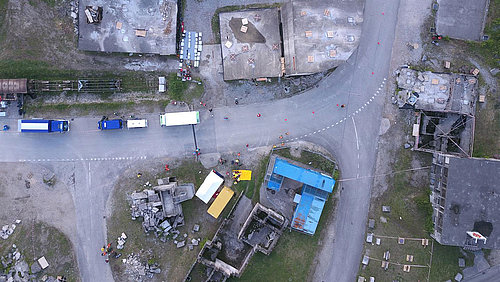Scientists from the German Aerospace Center (Deutsches Zentrum für Luft- und Raumfahrt; DLR) teamed up with I.S.A.R. Germany (International Search and Rescue) and Germandrones to take part in an international disaster rehearsal from 8 to 10 May 2017. Monitored by representatives of the United Nations (UN), the camera system MACS (Modular Airborne Camera System) provided relief forces deployed on the ground with situational pictures in near real time, thus enabling a faster and more efficient rescue chain.
The scenario: an earthquake of magnitude 7.5 on the Richter scale
The scenario for the exercise was as follows: a major earthquake of magnitude 7.5 on the Richter scale had occurred south west of Geneva. Several villages located within 10 kilometres around the epicentre had suffered extensive damage. As in real-life situations, the extent of damage to infrastructures and the number of casualties were initially uncertain. Although this was 'just' an exercise, it entailed a lot more for the people involved: they had to demonstrate their ability to organise and execute a rapid and seamless chain of rescue even in the most serious of cases. Accordingly, the exercise was carried out under the watchful eyes of the UN, which assessed and certified the performance of I.S.A.R. Germany and the German Federal Agency for Technical Relief (SEEBA, the rapid deployment unit for foreign rescue missions). The MACS camera system developed by the DLR Institute of Optical Sensor Systems supported the relief workers on the ground. "We are extremely proud to have been part of this exercise and that DLR-developed technology is an important and valuable tool for humanitarian aid," says Dennis Göge, Programme Coordinator Defence & Security Research at DLR.
Digital maps in just minutes
The first 72 hours are crucial when saving human lives. For the rescue workers, rapid and precise information about the situation is crucial for coordinating further actions. "This requires a large number of up-to-date maps showing which access roads are usable, as well as the actual extent of damage," says Ralf Berger, project director at the DLR Institute of Optical Sensor Systems. The MACS camera system delivers maps precisely for this purpose, projecting the latest aerial images directly onto a globally accessible surface model of Earth and superimposing them onto a digital map. It is also essential to obtain information regarding the location of possible survivors in order to deploy the emergency services efficiently. "Detailed information is important. The teams on the ground need to know precisely which residential areas, schools or shopping centres have been affected, and whether it is reasonable to expect that large numbers of people had gathered at these locations at the particular time of day," adds Berger.
The camera is mounted on a high-speed, unmanned aircraft developed by Germandrones, which has the capacity to lift off and land vertically. This special vehicle has a range of up to 30 kilometres and can achieve a top speed of 120 kilometres per hour. The unmanned aircraft can be deployed to acquire initial situational images while the rescue workers are still setting up their camp, ensuring that valuable time is used efficiently – during the day and, in future, at night as well.
Small crate with great performance
By participating in the international exercise in Switzerland, DLR researchers were able to demonstrate how special camera technology can support humanitarian aid missions. "In tandem with the unmanned aircraft by Germandrones, the camera system is an ideal solution to obtain an immediate impression of the disaster area as quickly as possible," says Daniela Lesmeister, President of I.S.A.R. Germany. Both the camera and the aircraft fit into a small crate just 120 x 50 x 80 centimetres in size, and are therefore easy to transport and deploy directly in the field.
Contacts
Melanie-Konstanze Wiese
German Aerospace Center (DLR)
Communication, Berlin and Neustrelitz
Tel.: +49 30 67055-639, Fax: +49 30 67055-102
Ralf Berger
German Aerospace Center (DLR)
DLR Institute of Optical Sensor Systems
Tel.: +49 30 67055-572
